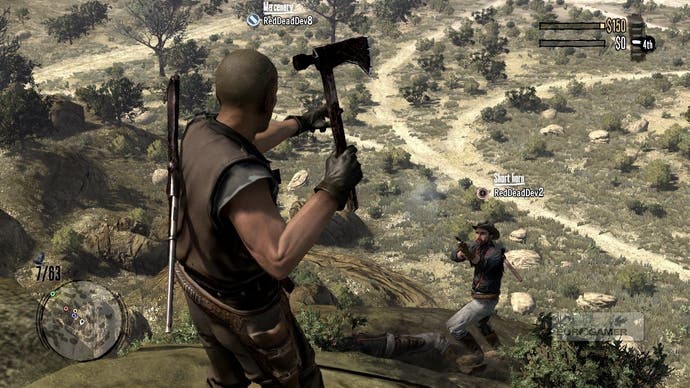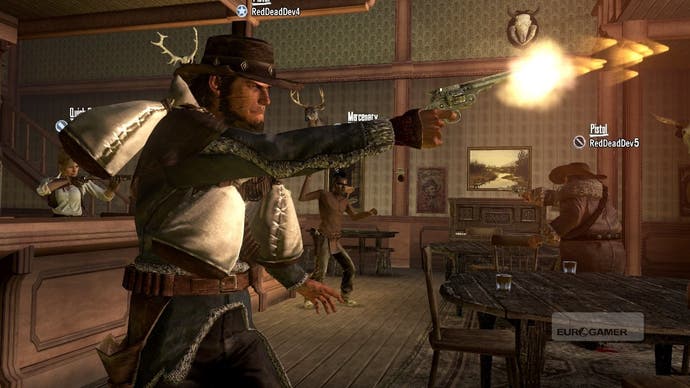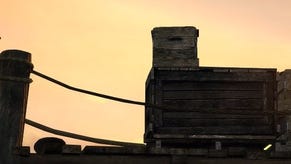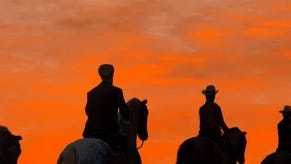Red Dead Redemption: Legends & Killers
Things of the wild frontier.
Nine new maps make up the meat of this multiplayer sandwich, the second batch of DLC for Rockstar's Western elegy, the first to demand payment. Ranging from open rural expanses to cover-heavy towns, all are extracted from the existing terrain, but some have had more of a makeover than others. Since these locations were created for atmosphere and single-player adventuring, they don't always lend themselves well to a nuanced multiplayer experience.
In the interests of completion, and because the game does a poor job of describing what you've bought (offering the new material only as a randomly chosen playlist from a dedicated menu option), the full combination of maps and modes is as follows...
The remote wilderness maps are Tall Trees (Hold Your Own), Manzanita Post (Grab the Bag, Hold Your Own), Punto Orgullo (Hold Your Own), Hennigan's Stead (Grab the Bag, Hold Your Own) and Rio Bravo (Gang Shootout, Gold Rush, Grab The Bag, Shootout).
For those who like the more comforting order of man-made structures there's Thieves' Landing (All Modes), Fort Mercer (Gang Shootout, Gold Rush, Grab The Bag, Shootout), Blackwater (All Modes)and Escalera (Gang Shootout, Shootout).

Three existing maps have also quietly had new modes added, with Diez Coronas gaining Grab the Bag. Pacific Union Railroad Camp gets to host both Shootout types while Tumbleweed now offers Gold Rush and Hold Your Own.
It's a large but curious collection with some combinations obviously more successful than others. Fort Mercer works well, since the location was clearly designed for repeated gang hideout missions, and the layout inevitably translates well to competitive play.
Punto Orgullo, on the other hand, works against the player in frustrating fashion, the maze-like tangle of deep rock gullies serving only to dilute team play for all but the most coordinated gangs. Blackwater's rather generic criss-cross streets and obvious rooftop sniper points wouldn't cut the mustard in any other multiplayer game, but since the location saw only limited action in the single player story there's still novelty value in wreaking havoc in this neat and tidy symbol of the Wild West's gentrified demise.

It's the unlikely choices that prove the most fun. In the solo game, Manzanita Post is a tiny collection of uninspiring buildings in the middle of a forest. Stretched out for multiplayer, the area is filled with log-built cover spots, watchtowers and gatling gun posts. A long, wide playing area liberates players from mindless choke points, the large central channel flanked by dense tree cover to one side and elevated positions to the other.
Being restricted to Grab the Bag and Hold Your Own matches enables its design to be specialised even further, providing dozens of routes for stealthy thieves to slip into enemy territory. The focus pays off, and it's one of the few maps where it feels like you're playing something designed for a specific multiplayer experience rather than just romping about in a familiar playground.
Other rural maps, such as Rio Bravo, are less successful. Small and contained, the map centres on the central spire of rock, run through with narrow passages and random cover points. Matches here soon fall in line with the chaotic terrain, encouraging play that is more about dashing around, getting kills where you can, rather than any tactical play. That's fine for Shootouts, but it makes it a curious choice for Gold Rush and Grab the Bag, where more co-ordination is needed.




